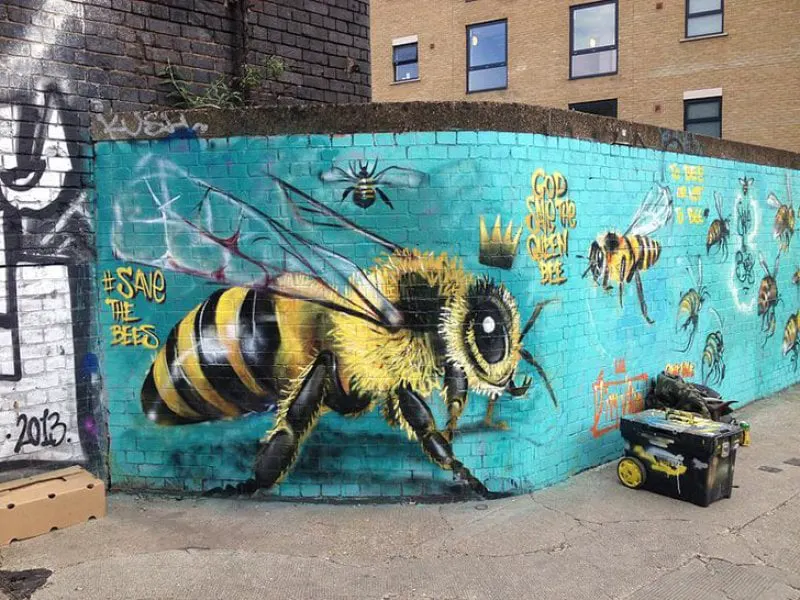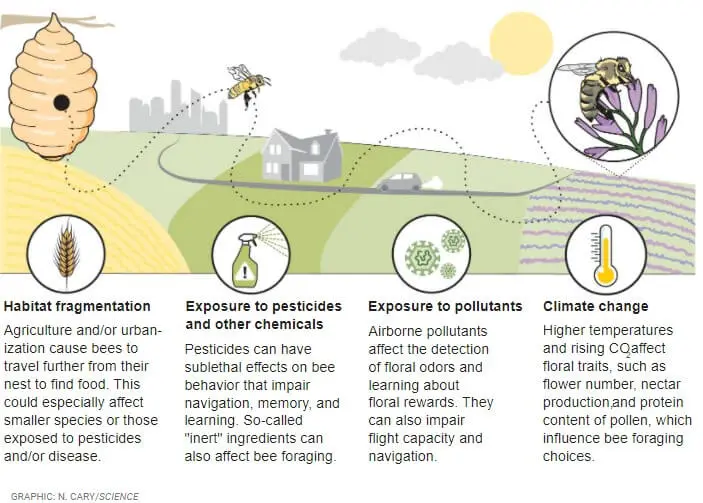Viewpoint: Human activity and modern agriculture are threatening pollinators
Viewpoint: Human activity and modern agriculture are threatening pollinators


The arrival of the Anthropocene has brought with it considerable challenges for wild bees. In particular, the spread of industrial agriculture has profoundly altered the landscape across large portions of the globe, often reducing the availability and diversity of floral resources.
The most widely grown crops (cereals such as wheat, rice, and corn, comprising 79% of global crop area) are wind-pollinated, and hence provide minimal resources for pollinators.
When grown in large monocultures, with extensive herbicide use to eliminate most weeds, the farmed landscape can be almost devoid of flowers.

If all this were not enough, climate change is likely to add further to the challenge of efficient foraging in bees.
Being large and furry, bumble bees are adapted to cool, temperate climates and can overheat in warm weather, becoming unable to forage. In specialist bees that have a narrow range of food plants, the timing of emergence of bees and flowering may become uncoupled, and their offspring may lack the ability to digest and develop on alternative pollen sources.
Rising CO2 concentrations can reduce the protein content of pollen, while extreme climatic events such as heat waves, fires, and droughts are likely to alter the ability of plants to produce floral resources, and such effects will undoubtedly get worse in coming decades.
This is an excerpt. Read the original post here.

 | Videos | More... |

Video: Nuclear energy will destroy us? Global warming is an existential threat? Chemicals are massacring bees? Donate to the Green Industrial Complex!
 | Bees & Pollinators | More... |

GLP podcast: Science journalism is a mess. Here’s how to fix it

Mosquito massacre: Can we safely tackle malaria with a CRISPR gene drive?

Are we facing an ‘Insect Apocalypse’ caused by ‘intensive, industrial’ farming and agricultural chemicals? The media say yes; Science says ‘no’
 | Infographics | More... |

Infographic: Global regulatory and health research agencies on whether glyphosate causes cancer
 | GMO FAQs | More... |

Why is there controversy over GMO foods but not GMO drugs?

How are GMOs labeled around the world?

How does genetic engineering differ from conventional breeding?
 | GLP Profiles | More... |

Alex Jones: Right-wing conspiracy theorist stokes fear of GMOs, pesticides to sell ‘health supplements’




 Viewpoint — Fact checking MAHA mythmakers: How wellness influencers and RFK, Jr. undermine American science and health
Viewpoint — Fact checking MAHA mythmakers: How wellness influencers and RFK, Jr. undermine American science and health Viewpoint: Video — Big Solar is gobbling up productive agricultural land and hurting farmers yet providing little energy or sustainabilty gains
Viewpoint: Video — Big Solar is gobbling up productive agricultural land and hurting farmers yet providing little energy or sustainabilty gains Trust issues: What happens when therapists use ChatGPT?
Trust issues: What happens when therapists use ChatGPT? Fighting deforestation with CO2: Biotechnology breakthrough creates sustainable palm oil alternative for cosmetics
Fighting deforestation with CO2: Biotechnology breakthrough creates sustainable palm oil alternative for cosmetics California, Washington, Oregon forge immunization alliance to safeguard vaccine access against federal undermining
California, Washington, Oregon forge immunization alliance to safeguard vaccine access against federal undermining 30-year-old tomato line shows genetic resistance to devastating virus
30-year-old tomato line shows genetic resistance to devastating virus The free-range chicken dilemma: Better for birds, but with substantial costs
The free-range chicken dilemma: Better for birds, but with substantial costs ‘You have to treat the brain first’: Rethinking chronic pain with Sanjay Gupta
‘You have to treat the brain first’: Rethinking chronic pain with Sanjay Gupta
